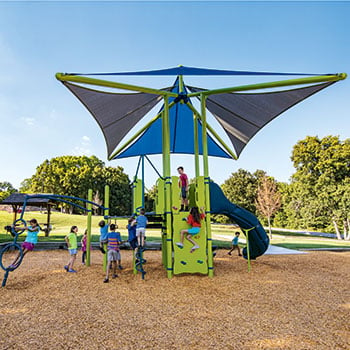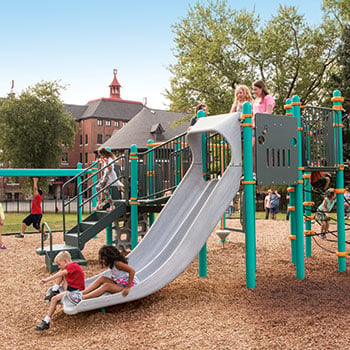Types of Playground Surfacing

Choosing the Right Playground Surface to Keep Kids Safe
There are many types of playground surfaces to choose from. We break our surfaces down into two categories, provide additional information on each and questions to guide your decision in selecting the right surface for your playground. After you have narrowed down your options or found the right playground surface, contact one of our expert consultants.
Available Playground Surfacing
When it comes to choosing a surface for public playgrounds such as schools or parks, there are several options to consider that are both safe and inclusive. These options are grouped into two major categories of surfacing: loose-fill and unitary.
Loose-Fill: Rubber Mulch, Wood Chips, Sand, Gravel & More
 Loose-fill material is typically installed by hand to create a level area over the entire playground. Rubber mulch, engineered wood fiber (EWF), playground sand, pea gravel and other bulk materials are considered loose-fill material. While loose-fill material has the least expensive upfront costs and is easy to install, it also requires more frequent maintenance to stay within safety and ADA guidelines.
Loose-fill material is typically installed by hand to create a level area over the entire playground. Rubber mulch, engineered wood fiber (EWF), playground sand, pea gravel and other bulk materials are considered loose-fill material. While loose-fill material has the least expensive upfront costs and is easy to install, it also requires more frequent maintenance to stay within safety and ADA guidelines.
Loose-fill materials will compress at least 25 percent over time due to use and weathering, and must be replenished to ensure the surfacing remains at the appropriate depth to adequately cushion falls. Generally speaking, 12 inches of loose fill material is recommended under and around playground equipment. Things like shards of glass, other sharp objects or animal waste can get buried in the loose material posing a potential hazard requiring the material to be replenished and/or replaced from time to time.
Unitary Materials: Rubber Mats, Tiles, Pour-in-Place & More
 Unitary materials are rubber mats and tiles or a combination of energy-absorbing materials held in place by a binder that may be poured in place at the playground site and then cured to form a unitary shock-absorbing surface.
Unitary materials are rubber mats and tiles or a combination of energy-absorbing materials held in place by a binder that may be poured in place at the playground site and then cured to form a unitary shock-absorbing surface.
Unitary surfaces include poured-in-place rubber, bond-in-place rubber, interlocking resilient tiles, and synthetic turf or grass with protective under-padding to help protect against falls. While the up-front cost is higher than loose-fill surfacing, unitary surfacing can be cheaper in the long run due to its high durability and low maintenance costs. Unitary surfacing is also extremely safe and guarantees complete accessibility and ease-of-use for visitors in mobility devices or wheelchairs. Poured-in-place and bond-in-place rubberized surfacing is also available in a wide variety of colors and shapes to make playgrounds more attractive to children and caregivers.
Choosing the Best Surfacing for Your Playground
 When choosing a surface for your playground it’s important to research the options and speak with experts. Your playground has unique needs and requirements, and a playground surfacing expert can help you determine which surfacing type meets the specific needs of your site and playground visitors.
When choosing a surface for your playground it’s important to research the options and speak with experts. Your playground has unique needs and requirements, and a playground surfacing expert can help you determine which surfacing type meets the specific needs of your site and playground visitors.
Whether choosing a playground surface for your school, community park or early childhood playground, the right surfacing depends on several variables: initial purchasing cost, installation cost, ongoing maintenance cost, long-term durability, visual appearance, degree of safety and degree of ADA compliance.
Questions to Ask When Choosing a Playground Surface:
- Is the surfacing soft enough and thick enough to lessen the impact of a child's fall?
- What age(s) is the playground designed for?
- Will the surfacing material become a choking hazard?
- What is the overall look and feel you are trying to achieve? Will the surfacing fit your design theme?
- How much time and money do you have available for ongoing maintenance and care?
- How much can you afford to spend both initially and over time?
- Is the surfacing ADA compliant?
One surface type may not fit all your needs. If that’s the case, you may want to consider incorporating multiple surfacing types into a single playground site. This can be more economical and promote sensory development through tactile transitions between different surfacing types. For example, rubber tiles around high traffic areas like slides and access points encourage play pathways to popular areas or transfer sites, while EWF can then be placed under high decks and adjacent open spaces.
Importance of Playground Surfacing
 Playground surfacing is a key factor to playground safety – according to the Consumer Product Safety Commission (CPSC), falls to the playground surface account for nearly 70 percent of all injuries. Installing playgrounds over dirt, grass, concrete or pavers with no safety surfacing are no longer safe options and can indeed be life-threatening. To minimize risk and improve playground safety, playground flooring must be soft enough and thick enough to lessen the impact of a child's fall.
Playground surfacing is a key factor to playground safety – according to the Consumer Product Safety Commission (CPSC), falls to the playground surface account for nearly 70 percent of all injuries. Installing playgrounds over dirt, grass, concrete or pavers with no safety surfacing are no longer safe options and can indeed be life-threatening. To minimize risk and improve playground safety, playground flooring must be soft enough and thick enough to lessen the impact of a child's fall.
Along with increased safety, certain playground surfaces also improve accessibility for playground visitors with mobility challenges. The Americans with Disabilities Act (ADA), which governs public playgrounds, requires that ground cover materials must accommodate all people, including physically challenged people who have mobility and footing issues such as people on crutches or in wheelchairs.
Playground Experts
 At Landscape Structures, we have a steadfast commitment to increasing playground safety. From the bolts on swings to the ground kids run on, we consider the entire play experience and constantly look for ways that improve play and keep kids safe. Play is one of the most organic ways kids learn and we take our involvement in this critical development seriously.
At Landscape Structures, we have a steadfast commitment to increasing playground safety. From the bolts on swings to the ground kids run on, we consider the entire play experience and constantly look for ways that improve play and keep kids safe. Play is one of the most organic ways kids learn and we take our involvement in this critical development seriously.
We’re not only improving the products we make, we’re creating industry standards to keep kids safe no matter which playground they are on. For 20 years, our Chairman Steve King was chairman of the task group of the ASTM committee that developed and updated standards concerning accessibility and safety in public playground equipment. Furthermore, our vice president of product development, Randy Watermiller, is on the board of directors of IPEMA, which is a non-profit organization promoting play and encouraging safety and product certification to keep playground environments safe.
For help in choosing a cost-effective playground surface, or for free resource materials that can help in your planning, call your local Landscape Structures consultant or browse our playground surfacing options.